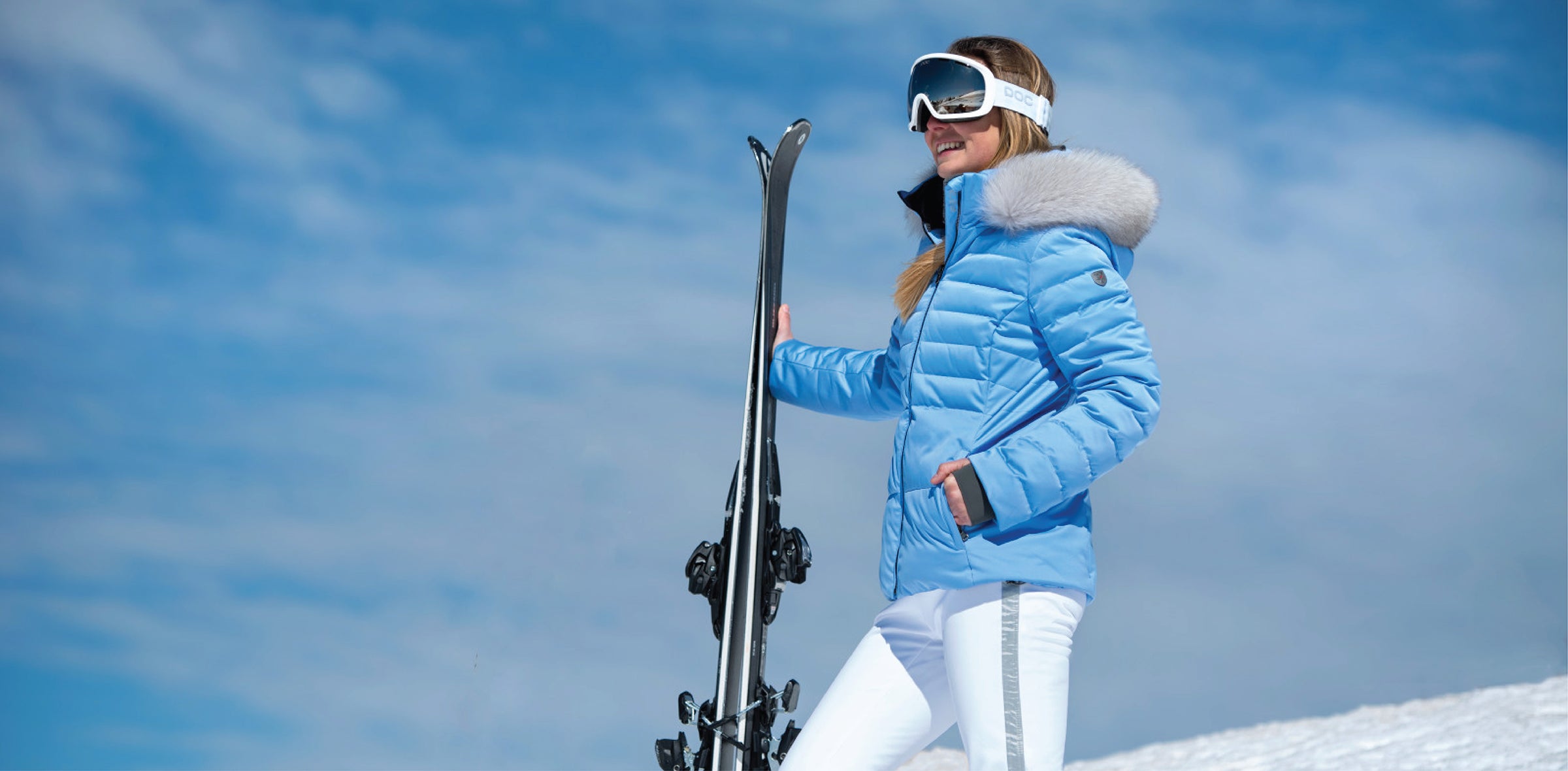Your Guide to FERA Fabrics and Features
FABRIC
Waterproof (WP) – functional fabric treatment to prevent water penetration. Waterproof ratings are measured in millimeters (mm), and represent the height of water that can be placed in a 1” square tube over the fabric before water penetrates the fabric. A tent fly, for example, rates 2000mm. Sitting on a chairlift exerts around 5000mm pressure.
The higher the fabric WP rating, the more waterproof the garment. High WP ratings matter most in wet rainy conditions like the Pacific Northwest. At low temperatures in dry zones like the Rockies, the moisture content of snow is in the single digits so high waterproof ratings aren’t critical unless you are sitting on the snow a lot.

Breathable – refers to the moisture vapor transmission of a fabric, or more simply, the evaporation of sweat. A breathability rating for a technical fabric measures the rate at which vapor passes through from inside to outside, in grams of water vapor per square meter in a 24hr period. This rating is typically abbreviated to “g/m2.” The more breathable the garment, the more comfortable it is. Since you perspire more through your upper body, breathability matters most in jackets. Look for 5k (5000) or higher.
DWR – Durable Water Repellent finish. A chemical treatment applied to fabric fibers so water beads and rolls off rather than saturating the fabric. With time and abrasion, DWR treatment wears off. Spray-on products like Granger’s help restore water repellency.
Mechanical Stretch – fabrics that have stretch properties through the weaving process, but do not use Lycra® or spandex yarns. Mechanical stretch fabrics do not stretch as much as 4-way and spandex fabrics.
4-Way Stretch – fabrics that contain Lycra® or spandex fibers to create exceptional stretch in 4 directions (up-down and side-to-side). 4-way stretch fabrics are ideal for closer-fitting garments where mobility is important, such as the Microtwill fabric of our Women’s Heaven Pant and Stowe Bib.
Laminated Fabric – fabric bonded with a polymer film for waterproof breathable function. Laminated fabrics are feel softer and quieter than coated ones and are typically more expensive. A 2-layer "2L" fabric comprises a face fabric and lamination layer, while a 3-layer "3L" fabric has an additional layer to protect the laminate and allow the fabric to be used without lining.
FERA’s 2L fabrics include:
FLUIDITY – A clean mechanical stretch polyester with a smooth hand and brilliant colors
MICROTWILL – 4-way stretch 90% nylon/10% spandex
FERA’s 3L fabric comprises our Microtwill with an added spandex fleece backing that adds warmth and a spongy thickness to the fabric. In the marketplace these fleece bonded fabrics are often referred to as "softshell"
INSULATION
Polyfill – used in the majority of performance insulated outerwear, polyester fiber insulations provide lightweight water-resistant thermal protection in a variety of weights and volumes, from Thermolite Active which is compact to others which give puffier down-like loft.
Down – the soft, light and fluffy feathers found under the tougher exterior feathers of duck or geese. Down feathers trap air, which helps insulate against heat loss. Down quality is rated according to the ratio of down feathers to other regular feathers. For example, 80/20 means the insulation is 80% down feathers and 20% other feathers. Down insulation is rated by fill power. The higher the fill power, the warmer and loftier the insulation.
Down blend – modern insulation technology blends natural down with other synthetic fibers to create hybrid insulations that combine the best characteristics of down and synthetic insulation. An example would be Primaloft Down, which combines down with Primaloft® for a warm and lofty insulation that dries more quickly than down and is more water-resistant.
Slimline – a signature of many FERA pants, comprising a compact foam-like insulation bonded with tricot, a uniquely light, smooth and strong fabric which takes the place of a separate lining layer. This low-profile layer gives the pants a more trouser-like look and feel, reducing bulk and weight.
SELECTED FEATURES
Lycra cuffs – inner cuffs inside sleeve openings that provide added warmth by retaining heat and blocking wind.
Powder skirt – an additional liner inside the base of a jacket with an elastic hem band that prevents heat loss and keeps wind and snow from getting in. We keep ours light and simple so you barely notice it.
Pant Connect loop – a webbing tab at the back of the jacket powder skirt that can be looped through the center back belt loop of pants to keep wind out.
Vents – dedicated zip openings in the garment for airflow and temperature regulation. Usually located at the armpit area.
Scuff Guards – an extra reinforcement layer at the inner pant cuff to protect against cuts from ski edges.

Selected features
Lycra cuffs
Inner cuffs inside sleeve openings that provide added warmth by retaining heat and blocking wind.
SWEATERS/KNITS
Merino Wool – refers to wool fibers from Merino sheep, which are regarded as having some of the finest and softest wool of any sheep. The long and soft fibers of their wool means merino knit is less itchy than some other types of wool, but carries the same characteristics of natural breathability and wicking.
Acrylic – synthetic textile fibers derived from acrylic acid. When acrylic is blended with wool fibers, it creates a non-itchy and more stable fabric.
Intarsia – a knitting technique used to create patterns with multiple colors.
Jacquard – a knitting or weaving technique where a pattern is incorporated into the knit rather than sewn or printed on. Most Nordic sweaters are jacquard.
Seamless – a computer knitting technique where most of the garment (such as the body/torso or leg) is produced in one piece without any seams or sewing. This creates a more comfortable garment.

